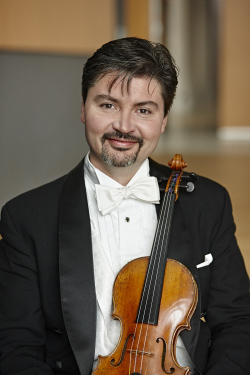
Photo credit: Joel Larson
The Minnesota Orchestra has been working hard to make things happen. Ever since we took the stage in our formalwear in an otherwise empty hall to play our final Friday night radio broadcast in March, we have been finding a way. We started with Minnesota Orchestra at Home, voluntarily recording videos as a thank you to our patrons. Some major donors got a private concert in their driveway. Our Artistic Advisory Committee put together a six-week series of outdoor chamber music concerts, and local radio and TV stations broadcast archived concerts every other week. And we negotiated a CBA extension of two years, with a COVID side letter that ICSOM counsel extraordinaire Kevin Case called “a solid agreement,“ which I believe is Kevin’s highest form of praise. I have it in writing.
How did we get here?
One of the main drivers of this success is the fact that we have a board, management, and musicians who are all on the same page, working tirelessly and methodically towards a common goal.
For the outdoor chamber music this summer, we were able to set up a small tented stage with a strong PA system in the public plaza adjacent to our hall. With safety protocols in place, we were guided through very specific routes of foot traffic backstage, and given limited arrival and departure windows. Each ensemble (two per concert) had a separate space for their cases, and specific timing to and from the plaza, so as not to run into the other group. Some rehearsals were at the hall, but my particular string quartet rehearsed in my yard. (Neighbors loved it, squirrels not so much.)
The plaza audience of between 100 and 200 was socially distanced on folding chairs, escorted in and out by wonderful (but strict) staff ushers.
Our safety measures came about because we have a wonderful tour physician, Dr. Jon Hallberg. He has donated his time and considerable effort to help us achieve our performance goals safely; he guided the drafting of our protocols (36 pages worth). Aside from a full-time private practice, Dr Hallberg also is on faculty at the University of Minnesota. He reached out to his colleagues in the mechanical engineering department, and set into motion the two-part aerosol study, testing our wind and brass players first in the lab, then on Orchestra Hall stage. The engineers were also able to ascertain our air turnover rate in the auditorium to be eight times per hour. The average turnover for any given ICU is six times per hour, so we are in good shape! Having had new HEPA filters installed in our 2012 renovation, we were ready to put our plans into motion.
The broadcasts are happening because of our long-standing partnership with Minnesota Public Radio, and a newer relationship with Twin Cities Public Television. Our board of directors quickly put together a fundraising drive ($150K) to rent the high-end video equipment we were lacking. A large room backstage has been turned into a video studio.
In our current phase of protocol, we are limiting occupancy on the stage to 25, conductor included. Each program is about an hour and 15 minutes long, featuring the different orchestra families separately. COVID tests happen on Monday, rehearsals start on Tuesday. All rehearsals and concerts have no intermission. Each player has their own assigned stand and chair, at least six feet from the nearest person, and only the stage crew moves anything. Music is provided by the librarians online, and then a hard copy at the first rehearsal. We are then in charge of our own music until the end of the concert. Some players choose to play from their iPads. In November and December we are gradually increasing our numbers to the low 50s. Utilizing a stage extension built by our amazing crew, we hope to be able to play Beethoven Symphony no. 1.
Our concerts are archived, and may be seen at no charge (for now) on our website, under the heading This is Minnesota Orchestra.
There is an empathetic provision in the side-letter that allows anyone uncomfortable performing with the group, high-risk or not, to take on modified duties (donor thank-you calls, etc.). Or, they may choose to do nothing at all, and the management will pay their COBRA fees to keep them on health insurance after their 13-week sick-leave period ends.
And now for the numbers:
We ratified a 20% pay cut on June 28. Until then we had been receiving 100%, due to a $4.5 million PPP loan that our management obtained. All of our insurance was untouched, and will remain so through the 2022 CBA extension. Our contract had expired on August 31, putting us in what should have been a weak negotiating position. However, we were able to simply extend our current contract through August 31 of 2022. This was ratified on September 16, and it all went into effect on October 1.
The COVID side-letter pinned on top of the extension lowers everyone’s pay to 75% of what they normally earn. Our Music Director and upper management took slightly steeper cuts. Our base annual salary with EMG is now $82,953. As soon as we are able to move off the side-letter, this will revert back to $110,604.
I was thrilled to see this quote in the paper from Brad Eggen, president of our Twin Cities Musicians Union: “In this time of extreme challenges, this group crafted a solution that preserves inspiring performance in a creative agreement respectful of the musicians’ careers and the well-being of all involved.”
While pay cuts of this magnitude are never easy, we believe that this agreement will help us to remain stable during the pandemic, and that it puts us in a position to thrive again when the pandemic ends.
Note: the author is ICSOM delegate for the Minnesota Orchestra.





